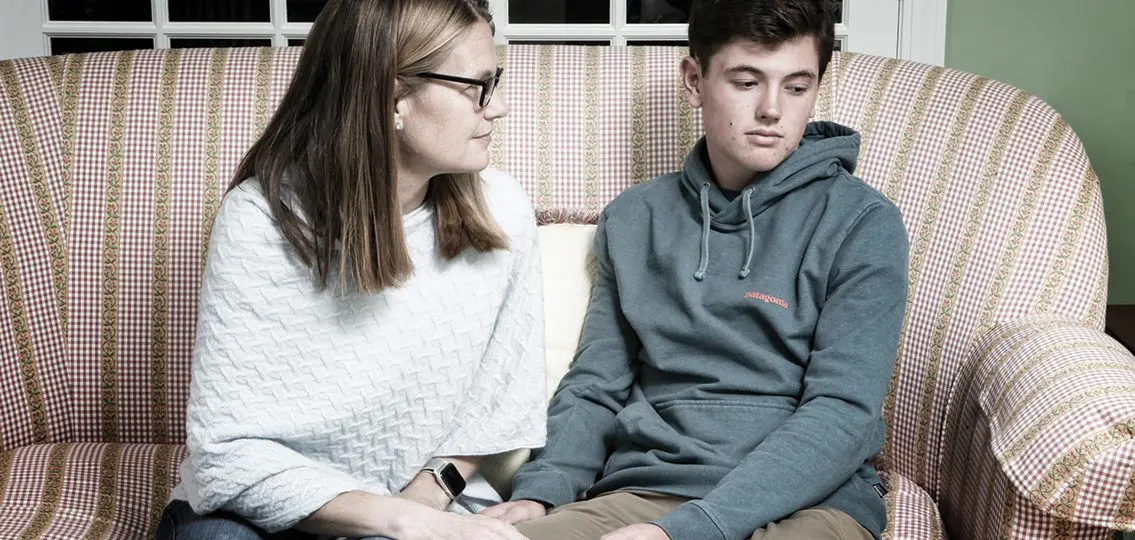T.J. Sefcik was handsome. Smart. Athletic.
“School came easily to him, and if he picked up a stick or a ball, it was magic,” says his mother, Wendy. “He played everything well.”

The middle son in a three-boy family, T.J. was a beloved member of his school’s lacrosse team and an avid surfer and dirt biker. At age 16, he started showing some serious irritability, but his parents and brothers brushed it off. After all, teenagers are not always entirely pleasant human beings.
When T.J. started picking fights with his siblings and disrespecting his father, his mother reprimanded him and issued punishments.
“I said, ‘You can’t talk like that. You can’t behave like that. It’s unacceptable!’ instead of stepping back and thinking, Wow, this behavior isn’t T.J. What’s going on?” says Sefcik.
Occasionally, T.J. would say something like, “nobody on the team likes me” or “school seems overwhelming,” but those comments seemed utterly ridiculous to his family. “Everyone loved T.J.,” his older brother (and lacrosse teammate) says. And T.J.’s grades—all A’s—certainly didn’t reflect any stress.
When T.J. died by suicide on December 1, 2010, shortly after his girlfriend broke up with him, his family was blindsided.
“I worried about my kids getting in accidents. I worried about them getting sick. But never, ever, ever did I worry that one of my kids would die by suicide,” Sefcik says.
Unfortunately, the risk of suicide is real and growing.
According to data from the U.S. Centers for Disease Control and Prevention (CDC), suicide rates for teens and young adults have reached their highest point in two decades. From 2007 to 2017, the suicide rate among 10- to 14-year-olds nearly tripled, and among 15- to 19-year-olds it increased 76 percent. Suicide is now the second-leading cause of death for 10- to 24-year-olds, and the suicide rate is three to four times higher among boys and young men compared to girls and young women.
High achievement doesn’t protect teens like T.J., either. A recent study by the National Academies of Sciences, Engineering and Medicine notes that youth who attend “high-achieving schools” (defined as schools with top test scores, a variety of extracurricular activities, and a track record of graduates going on to top colleges) experience higher rates of mental health problems than students at less selective institutions.
Of course, none of that information helps the Sefcik family. T.J.’s family still feels his absence acutely. They can’t bring T.J. back, but they can share their story with others, which is exactly what Wendy does as a member of the New Jersey Youth Suicide Prevention Advisory Council and the New Jersey Chapter of The American Foundation for Suicide Prevention.
“The reality is that kids are struggling with depression and anxiety,” Sefcik says. “We need to take a deep breath with our kids [and address that reality], and I’m saying that as a mom who thought she was doing everything right.” While there’s no “right” or perfect way to parent through these difficulties, experts offer these tips on how to check in with your own family.
Suicide Prevention: Breathe. Then Talk.
First, don’t panic. Yes, suicide rates are rising, but “the risk of suicide is very, very small statistically” for any child, says Kari Eckert, a suicide loss survivor and founder of Robbie’s Hope, a nonprofit dedicated to the memory of her son Robbie, who died at age 15.
It’s not easy to think or talk about suicide, but this conversation is crucial. Suicide prevention, both at an individual and at the societal level, is all about facilitating mental health. Avoiding the subject or reacting based on fear won’t help our kids.
“Adults need to move beyond the fear,” says Katey McPherson, an educator and mental health advocate who jumped into action after more than 30 teens in her East Valley, Arizona, region died by suicide in less than two years. “Suicide prevention is really about coping and resilience. We help our kids by building their coping and resilience skills so that when there is anxiety, when there is depression, they have the skills to get through it with their parents’ support and guidance.”
Being willing to talk about mental health is a key first step.
Recognize Suicide Warning Signs
Here’s the tricky thing: Many of the warning signs for suicide also sound a lot like typical teen behavior. Isolation? Check. Overwhelming emotions? Check. Sleeping too much or too little? Check and check. Mood swings…you get the point.
The key, Eckert says, is to look for changes in behavior.
Certainly, some changes are normal; 13-year-olds act differently than they did at age 11, and they may take on new interests or friends. But, try to pay attention to out-of-character changes that persist over a period of time, such as T.J. Sefcik’s increasing irritability.
“That was not typical behavior for him,” his mom says. “It went on for over a year. I knew something was going on with my son, but I couldn’t put my finger on it.”
In hindsight, Sefcik wishes she’d asked her son about his behavior and listened more carefully to what he was saying. Instead of, “You’re getting all A’s in your classes; how overwhelming could it possibly be?” she says, “I could have said, ‘Wow, that must be really hard. You want to talk more about it?’”
Listen Carefully
McPherson says hundreds of teens have told her the same thing: Parents are too quick to intervene, rather than listen. Be careful with your language. There’s a big difference between, “You’re okay, right?” and “Is there something you want to share?” One tells your child what you want to hear; the other signals a willingness to listen.
If your child shares a tough emotion or situation, take it in stride. Freaking out does not help. Instead, it signals to your kids that you’re not to be trusted. If you can’t manage your own emotions, how in the world are you going to help them work through theirs?
Avoid offering quick fixes as well. “One thing teenagers tell us is that they don’t go to their parents because their parents offer solutions,” Eckert says. “The parents turn it into their own problem.”
McPherson says hundreds of teens have told her the same thing. “We parents are so quick to try to fix or intervene, or, worse, minimize or dismiss,” she says. What kids really need is someone to listen to them, validate their emotions, and help them develop strategies and skills to move beyond their current discomfort.
“It’s not your job to carry your kid out of the ditch. We actually do our kids a disservice when we throw them over our shoulder and walk up the ladder because then they never learn how to grow and stretch through pain,” McPherson says. Instead, “get in the ditch together. Be vulnerable. Validate their feelings. Literally bring your household to a screeching halt to make time for this conversation, if you have to.”
Talk about Suicidal Thoughts
It’s okay to directly ask your child if he is thinking about suicide; research studies repeatedly find that asking about suicidal thoughts or feelings does not increase risk. Suicidal thoughts, in fact, are pretty common. According to 2017 CDC data, 17% of high school seniors seriously considered suicide over a 12-month period. Most teens that have suicidal thoughts, however, never attempt suicide.
“Having thoughts doesn’t necessarily mean your teenager is suicidal. It does mean that they’re probably not feeling so good and have some stuff going on that they need to talk about,” Sefcik says.
If your child—or anyone else—admits suicidal thoughts to you, say, “Thank you for trusting me and sharing that with me,” says Sally Spencer-Thomas, a psychologist and president of United Suicide Survivors International. Then, demonstrate your love and support: “I’ll walk with you through this. We’re going to figure it out together.”
The next steps will vary from person to person. “The whole process needs to be collaborative and really empower the affected person,” Spencer-Thomas says. Calling 911 or hospitalizing your child against their will may not be the best option; often, “the least restrictive intervention has far more likelihood of being effective,” Spencer-Thomas says.
Not sure what to do? Call the U.S. National Suicide Prevention Lifeline at 800-273-TALK (8255); it’s free and available 24/7, or text HOME to Crisis Text Line at 741741. Also, secure (or have someone else secure) all firearms, medications, and sharp objects.
“This is a super-important life-saving step,” Spencer-Thomas says. “The more time we can build in for anyone in a suicide crisis, the better the chances are that we will save their lives.”
Ideally, all parents will also help their children develop the strength and skills necessary to persist through pain. And ideally, we’ll keep our primary focus on their emotional well-being and mental health, rather than on their academic or extracurricular achievement. “We all need to redefine what a successful kid is,” Sefcik says. “If they are mentally and emotionally well, the rest will take care of itself.”
Warning Signs of Suicide
- Talking about wanting to die
- Looking for a way to kill oneself
- Talking about feeling hopeless or having no purpose
- Mentioning feeling trapped or in unbearable pain
- Talking about being a burden to others
- Persistent anger and irritability
- Behavior changes that persist over a period of weeks
- Increasing the use of alcohol or drugs
- Acting anxious, agitated, or reckless
- Sleeping too little or too much
- Withdrawing or feeling isolated
- Showing rage or talking about seeking revenge
- Displaying extreme mood swings
What to Do:
- If someone you know exhibits warning signs of suicide:
- If self-harm seems imminent, dial 911.
- Listen. Ask questions, acknowledge their feelings.
- Remain with the person.
- Remove any guns, alcohol, drugs, or sharp objects that could be used in a suicide attempt.
- Call the U.S. National Suicide Prevention Lifeline at 800-273-TALK (8255) or text HOME to Crisis Text Line at 741741.
- Seek help from a medical or mental health professional.





